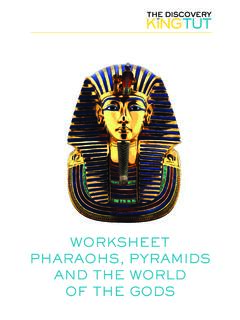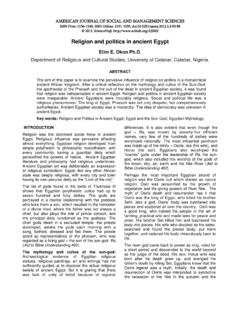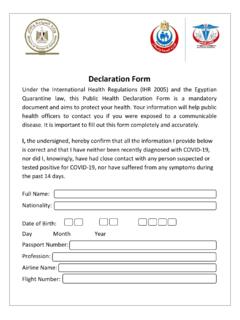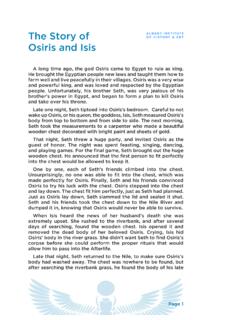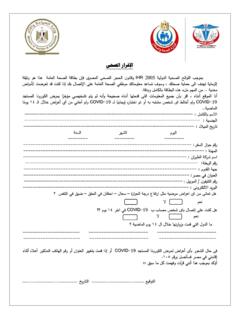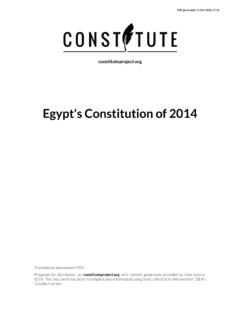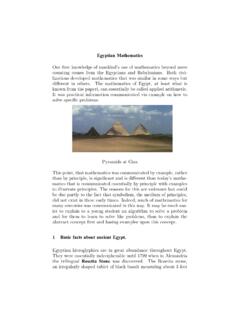Transcription of WORKSHEET THE NILE
1 WORKSHEETTHE NILE2 Developed by Facts & Files Historisches Forschungsinstitut Berlin, for TUTANKHAMUN HIS TOMB AND HIS TREASURES and THE DISCOVERY OF KING TUT, 2008-2014 | Research Consultants: Susanne Martinssen-von Falck, and Dr. Wolfgang Wettengel1. THE NILEE gypt is a hot country where it hardly ever rains. Even so, people were able to live there from farm-ing over 6,000 years ago. How was that possible? Every year in the tropical regions at the source of the River Nile, there were periods of long, heavy rainfall. The river swelled so much that it flooded the area along the banks with water and fertile mud. People learned to manage the Nile flood by building canals and dams. With special lifting de-vices, they could carry water to the higher fields. Suggested Activity1. Find egypt on a map of the world or of Africa, copy the map and color in the Mark the following towns on your map of egypt : Alexandria, Cairo, Luxor, and Find out about the city of Alexandria from a textbook or the internet.
2 Where did it get its name from?4. Look in a textbok to find out about egypt today. Draw a table showing: size, population, politics, natural resources, agricultural products, tourism, in the fields was hard but the yields were high. The introduction of methods to store the harvest made it possible to avoid famine in years of poor harvests. People who knew how to calcu-late the floods and measure the fields were highly regarded and attained power and respect in the villages. Towns soon began to develop under the rule of princes and chieftains. Around 3000 the two regions of Lower and Upper egypt were united as one country ruled over by a pharaoh. 3 Developed by Facts & Files Historisches Forschungsinstitut Berlin, for TUTANKHAMUN HIS TOMB AND HIS TREASURES and THE DISCOVERY OF KING TUT, 2008-2014 | Research Consultants: Susanne Martinssen-von Falck, and Dr.
3 Wolfgang Wettengel2. MAP OF egypt AT THE TIME OF THE PHARAOHSS uggested Activity1. Cut out the pictures and stick them on the map in the proper Color in the map blue for water, green for fertile land, yellow for the desert and light brown for Find out more about a few particular buildings and show the information in a list of of GizaHall of Columns in Karnak TempleRock-cut temple of Ramesses II at Abu SimbelMask of Pharaoh Tutankhamun fromthe Valley of theKings at WesternThebesFigure of Akhenaten and Nefertiti from AmarnaTemple of Queen Hatshepsut at Western ThebesHorus Temple in EdfuRosettaGizaAssyutAbydosWestern Thebes /Valley of the KingsKarnakLuxor (Thebes)Kom OmboAswan/ElephantineEdfuAbu Simbel0100milesDenderaSaqqaraMedinet el-FayumAlexandriaBubastisCairoMemphisDa shurLishtMeidumHawaraBeni HasanAmarnaBitter LakesSinaiNile DeltaNubiaMEDITERRANEAN SEA project map egypt , by Dieter Potente, Cornelsen Verlag Berlin 20024 Developed by Facts & Files Historisches Forschungsinstitut Berlin, for TUTANKHAMUN HIS TOMB AND HIS TREASURES and THE DISCOVERY OF KING TUT, 2008-2014 | Research Consultants: Susanne Martinssen-von Falck, and Dr.
4 Wolfgang Wettengel3. HERODOTUS AMAZEMENT AT THE WONDERS OF EGYPTA Greek traveler amazed by egypt The Greek scholar Herodotus (c. 484-425 ) was born in Halicarnassus in Asia Minor. He traveled widely and got to know the lands of Mesopotamia, the east coast of the Black Sea, Sicily and parts of Africa. He was a keen observer and listened closely, if sometimes too believingly, to the stories the local people told him. His work The Histories is seen as the first important history book ever written and he is known as the Father of History. Around 450 , Herodotus traveled through egypt . Much of what he saw and heard there filled the man from Greece with amaze-ment. On the geography of the country the regions of are new land given by the Inland from the sea as far as Heliopolis, egypt is a wide land, all flat and watery and Beyond and above Heliopolis, egypt is a narrow land.
5 For it is bounded on the one side by the mountains of Arabia, which run north to south, always running south towards the sea called the Red Sea. In these mountains are the quarries that were hewn out for making the pyramids at On the side of Libya, egypt is bounded by another range of rocky mountains among which are the pyramids; these are all covered with sand, and run in the same di-rection as those Arabian hills that run From Heliopolis to Thebes is nine days journey by On agriculture At present, of course, there are no people, either in the rest of egypt or in the whole world, who live from the soil with so little labor; they do not have to break the land up with the plow, or hoe, or do any other work that other men do to get a crop; the river rises of itself, waters the fields, and then sinks back again; then each man sows his field and sends swine into it to tread down the seed, and waits for the harvest; then he has the swine thresh his grain, and so garners it.
6 On the Nile Concerning its nature, I could not learn anything either from the priests or from any others. Yet I was anxious to learn from them why the Nile comes down with a rising flood for a hundred days from the summer solstice; and when this number of days is passed, sinks again with a diminishing stream, so that the river is low for the whole win-ter until the summer solstice again. I was not able to get any information from any of the Egyptians regarding On customs and traditions Among them, the women buy and sell, the men stay at home and Men carry burdens on their heads, women on their shoulders. Women pass water standing, men sitting. They ease their bowels indoors, and eat out of doors in the Herodotus Cornelsen Verlag, Berlin5 Developed by Facts & Files Historisches Forschungsinstitut Berlin, for TUTANKHAMUN HIS TOMB AND HIS TREASURES and THE DISCOVERY OF KING TUT, 2008-2014 | Research Consultants: Susanne Martinssen-von Falck, and Dr.
7 Wolfgang Wettengel3. HERODOTUS AMAZEMENT AT THE WONDERS OF No woman is dedicated to the service of any god or Everywhere else, priests of the gods wear their hair long; in egypt , they are shaven. For all other men, the rule in mourning for the dead is that those most nearly concerned have their heads shaven; Egyptians are shaven at other times, but after a death they let their hair and beard grow. The Egyptians are the only people who keep their animals with them in the The Greeks write and calculate from left to right; the Egyptians do the Suggested Activity 1. Read the report from Make up a dialogue between an Egyptian man and Herodotus. The Egyptian tells the Greek something about his country and Herodotus describes his homeland Greece (use this text, an atlas, your history books or a textbook.)3. Trace the course of the Nile in an atlas (what countries does it flow through, where are the sources of the Blue and the White Nile?)
8 Maybe now you can clear up some of the questions about the Nile that Herodotus couldn t answer!4. Have a look round the exhibition and see if you can find objects that show animals and plants. Find out what religious significance some of the animals and plants had for the Ancient by Facts & Files Historisches Forschungsinstitut Berlin, for TUTANKHAMUN HIS TOMB AND HIS TREASURES and THE DISCOVERY OF KING TUT, 2008-2014 | Research Consultants: Susanne Martinssen-von Falck, and Dr. Wolfgang WettengelSuggested Activity1. Read the paragraph below and explain with the help of your his-tory book or an encyclopedia why the Egyptians welcomed the annual flooding of the Write the headings Sowing , Harvest and Flood in the right order on the drawing of the Describe the work that the farmers had to carry out each season. 4. In Text C, you can see the water level of the Nile at different times of the year.
9 Make a bar chart of the water levels and mark the seasons in different EGYPTIAN SEASONSW ater levels for the Nile 4,000 years ago:January m July mFebruary m August mMarch m September mApril m October mMay m November mJune m December mFlooding of the Nile: Celebrations in EgyptGiza, 15th June in year 12 of the reign of Pharaoh Khufu: As they do every year, the inhabitants of Giza have been celebrating the start of the Nile flood. Many fields are already under water and covered with the fertile mud from the river. Experts expect water levels to rise to eight meters above normal by October. That promises a good harvest but it s a long time away yet. First of all, the water will turn our country into a huge lake for three months. This is the time when farmers can work on the building sites of our great pharaoh. Then the sowing will begin.
10 But we ll have to wait until February next year for the harvest. 7 Developed by Facts & Files Historisches Forschungsinstitut Berlin, for TUTANKHAMUN HIS TOMB AND HIS TREASURES and THE DISCOVERY OF KING TUT, 2008-2014 | Research Consultants: Susanne Martinssen-von Falck, and Dr. Wolfgang Wettengel4. EGYPTIAN SEASONS1 5 J une 1 5 O ctobe r1 5O ctobe r 1 5 F e bruary1 5 F e bruary 1 5 J une project map egypt , by Dieter Potente, Cornelsen Verlag Berlin 20028 Developed by Facts & Files Historisches Forschungsinstitut Berlin, for TUTANKHAMUN HIS TOMB AND HIS TREASURES and THE DISCOVERY OF KING TUT, 2008-2014 | Research Consultants: Susanne Martinssen-von Falck, and Dr. Wolfgang Wettengel5. LET S MAKE A MODEL OF THE NILETo make a model of the Nile you will need the following materials and tools: A board (1 m x .5 m) Card Paper Pencils, watercolors and paintbrushes.
